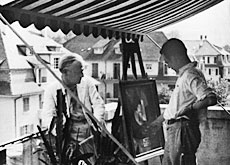
The Bernese artist who was not Swiss

Paul Klee died before becoming a Swiss citizen, but it's probably thanks to the delay that his estate remained in Bern and could later be transferred to the new centre.
Four Bernese collectors prevented Klee’s artistic heritage from being sold off and being dispersed by buying it themselves.
That the city of Bern took so long to grant Klee Swiss nationality is something that is still held against it.
The centre, in the words of former city mayor Klaus Baumgartner, is “the unique chance to make it up to Paul Klee and his family”.
However, such a centre would hardly have been possible if Klee had been naturalised earlier.
Soon after the Nazis came to power in 1933, they began to target figures from the world of modern art. Klee’s home in Dessau was searched by the police and Nazi Storm Troopers.
Soon afterwards, the Nazis banned “degenerate” artists (who included Klee) from painting and suspended Klee from his professorship at Düsseldorf’s Fine Arts Academy.
On December 23, 1933, Klee and his wife Lily went into exile in Bern.
Exiled at home
Klee was born in Bern, had gone to school there and was eventually buried there.
But his German father, Hans, had never bothered to become Swiss. This meant that Klee returned to his homeland as an immigrant.
In spring 1934 Klee submitted an application for citizenship. This was rejected on the grounds cited in the Berlin Convention of 1933.
This allowed German citizens to apply for Swiss nationality only after five consecutive years in Switzerland.
Five years later, in April 1939, Klee filed a second application.
The police scrutinised his forms very carefully because, just like in Nazi Germany, the confrontation between traditional and modern art in Switzerland had taken a turn for the worse.
In the public perception, modern art was closely linked to left-wing politics.
Secret reports
Filing secret reports to the police chief of canton Bern, an unnamed policeman put together a dossier on Klee.
In it, he warned against the bad influence Klee’s art could have on Swiss culture.
He described Klee’s works as products of a sick mind and finally rejected the notion that the artist had any true link to Switzerland.
Despite the dossier’s contents, Klee’s application received the stamp of approval from the federal government on December 19, 1939.
However, he still had to apply to the city of Bern to complete his attempt to become Swiss.
The local authority decided it would seal the matter once and for all on July 5, 1940. But Klee died a week before this date and so the matter was not closed.
His widow Lily remained in Bern as a German citizen and become administrator of her husband’s artistic estate.
In September 1946 she fell seriously ill. Her son and sole heir, Felix, was on the run at that time as an escaped Russian prisoner-of-war.
Saving the collection
In the event of Lily’s death, the estate would normally pass to Felix but there was one stumbling block – the Washington Convention.
Formulated by the Allied Forces, this demanded the liquidation of any assets held by Germans in Switzerland to help fund reconstruction in countries ravaged by the Second World War.
To avoid Klee’s estate being sold off, friends of the couple bought all the artistic works from Lily two days before her death on September 20, 1946.
The group, which included Hans Meyer-Benteli, Hermann Rupf, Rolf Bürgi and Werner Allenbach, then transferred the collection to the Klee Society.
A year later, the latter set up the Paul Klee Foundation and deposited the collection in Bern’s Kunstmuseum or Museum of Art.
Staking a claim
In 1948 Felix moved with his family to Bern, where he staked his claim to his father’s estate.
A four-year legal battle ensued with the Foundation’s trustees before the parties reached an out-of-court settlement. The collection was divided into two parts, both of which remained in Bern.
The two collections have now finally been reunited thanks to the heirs of Felix, the Foundation and the Bernese authorities, and have a new home in the Paul Klee Centre.
swissinfo, Nicole Aeby
After Klee died on June 29, 1940, his widow Lily was left in charge of his artistic estate.
When she fell seriously ill in 1946, four collectors bought the works and Klee’s library for SFr120,000.
They then set up the Klee Society, to which the collection of 3,000 works was transferred.
In 1947 the society set up the Paul Klee Foundation.

In compliance with the JTI standards
More: SWI swissinfo.ch certified by the Journalism Trust Initiative





























You can find an overview of ongoing debates with our journalists here . Please join us!
If you want to start a conversation about a topic raised in this article or want to report factual errors, email us at english@swissinfo.ch.